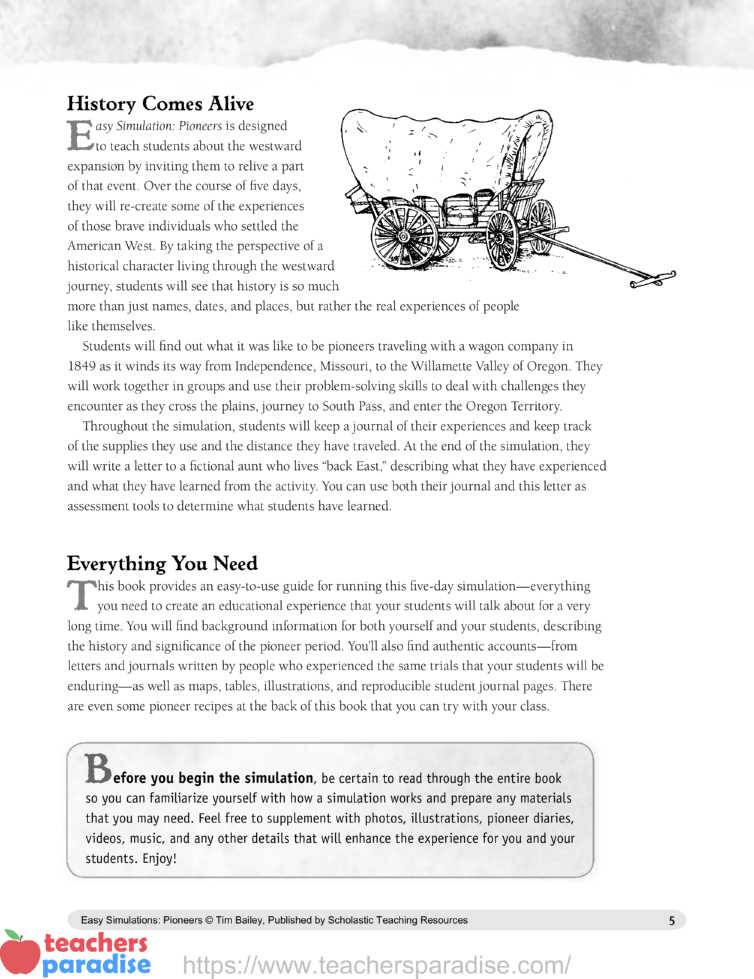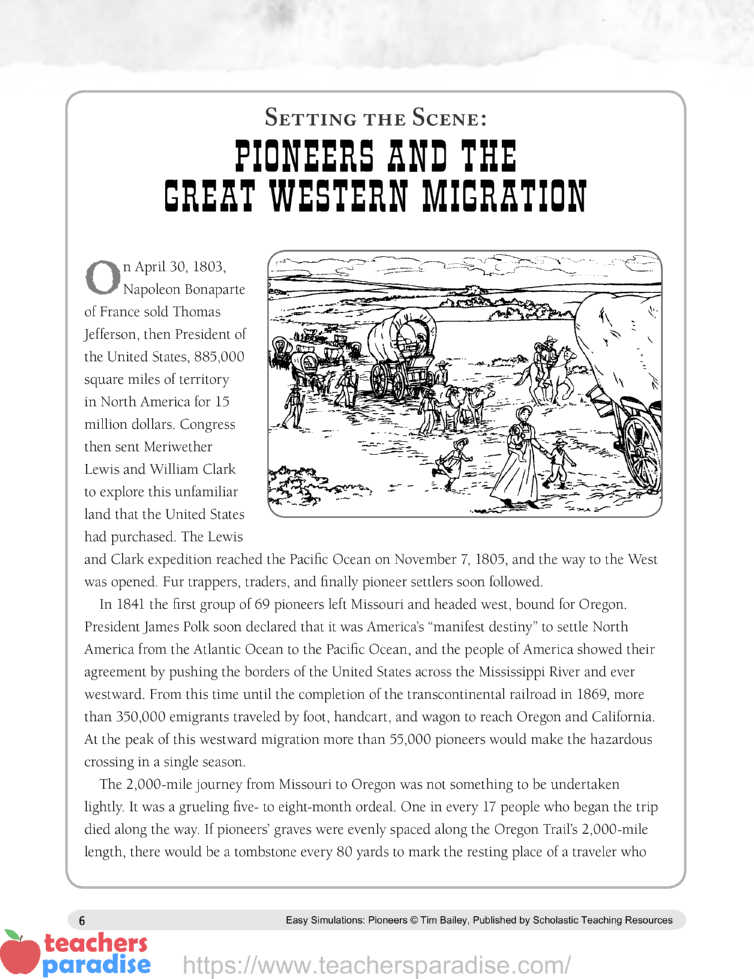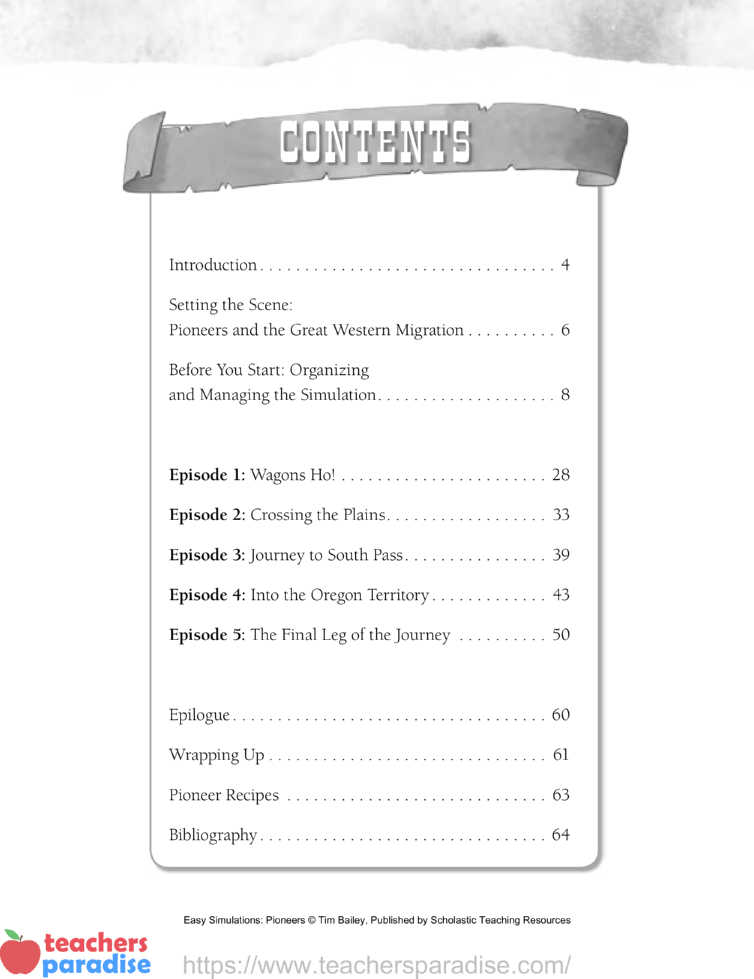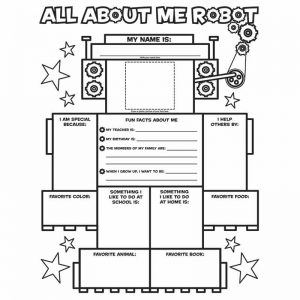1800’s Pioneers Worksheet & Activity
December 8, 1849
Dear Aunt Bertha,
. . . It was real hard most of the time. There wasn’t just fun and games. A matter of fact there really wasn’t any fun or games. It was really hard sometimes. I just thought we would die and given up hope.
History Comes Alive
Easy Simulation: Pioneers is designed to teach students about the westward expansion by inviting them to relive a part of that event.
Students will find out what it was like to be pioneers traveling with a wagon company in 1849 as it winds its way from Independence, Missouri, to the Willamette Valley of Oregon. They will work together in groups and use their problem-solving skills to deal with challenges they encounter as they cross the plains, journey to South Pass, and enter the Oregon Territory.
WORKSHEET & Sample PDF Activity
Sample PDF Activity
Throughout the simulation, students will keep a journal of their experiences and keep track of the supplies they use and the distance they have traveled. At the end of the simulation, they will write a letter to a fictional aunt who lives “back East,” describing what they have experienced and what they have learned from the activity. You can use both their journal and this letter as assessment tools to determine what students have learned.

Everything You Need
… You’ll also find authentic accounts—from letters and journals written by people who experienced the same trials that your students will be enduring—as well as maps, tables, illustrations, and reproducible student journal pages. There are even some pioneer recipes at the back of this book that you can try with your class.
Setting the Scene:
Pioneers and the Great Western Migration
On April 30, 1803, Napoleon Bonaparte of France sold Thomas Jefferson, then President of the United States, 885,000 square miles of territory in North America for 15 million dollars. Congress then sent Meriwether Lewis and William Clark to explore this unfamiliar land that the United States had purchased. The Lewis and Clark expedition reached the Pacific Ocean on November 7, 1805, and the way to the West was opened. Fur trappers, traders, and finally pioneer settlers soon followed.
The 2,000-mile journey from Missouri to Oregon was not something to be undertaken lightly. It was a grueling five- to eight-month ordeal. One in every 17 people who began the trip died along the way. If pioneers’ graves were evenly spaced along the Oregon Trail’s 2,000-mile length, there would be a tombstone every 80 yards to mark the resting place of a traveler who did not survive the journey. Lives were claimed by starvation, accidents, outlaws, hostile Native Americans whose lands were being invaded, and, perhaps most aggressively, by the dreaded disease cholera.
While these reasons pulled people West, a number of factors pushed people out of the East. A series of financial crises that began in 1837 brought about a depression and ruined many farmers. In addition, several disease epidemics, including typhoid, dysentery, tuberculosis, scarlet fever, malaria, and yellow fever, were sweeping through many parts of the eastern United States. Perhaps the most devastating disease was cholera, which had arrived from Asia in the 1830s, and accounted for more than 50,000 deaths in 1850.
Before You Start
Organizing and Managing the Simulation
• Traveling the Oregon Trail (pages 17–18)
• Choose a Role (page 19)
• A Pioneer’s Diary (pages 20–21)
• Wagon Company Journal (pages 22–23)
• Wagon Supplies (pages 24–25)
• Rubrics (page 26)
• Simulation Spinner (page 27)
Choosing a Role
Students have to pay special attention to the Health and Food attributes. Health can change throughout the simulation, depending on circumstances. The Food number, while technically not a real attribute, indicates how many pounds of food a pioneer consumes each day.

Attributes
Attributes are the numbers that make each pioneer role unique. The attributes are Strength, Common Sense, Hunting/Fighting Skills, Negotiation Skills, Medical Expertise, and Health.
In order to move the tree, a wagon-company member (a student) must make a spin and compare that number to her Strength attribute. If the number she spins is equal to or lower than her Strength attribute, she has succeeded in moving the tree. If the number spun is higher, then she has failed.
Hunting/Fighting Skills: How skilled a pioneer is at hunting for food and at fighting using either a pistol or rifle.
Negotiation Skills: How well a character can reason with or influence other people. A good negotiator can get a better price or can defuse a dangerous situation, while a poor negotiator could end up insulting the person with whom he is talking.
Other Important Features
Included in the table under “Choose a Role” are two features that are not actual attributes, but are nevertheless important in the pioneer experience:
Food: This number indicates how many pounds of food a person consumes every day. The Food number of every member in a wagon company will be added up to determine how much food will be subtracted from the company’s supplies for each day of the journey.
One of the greatest challenges for students is having enough food to complete the journey. This was also the case for the real pioneers who made this trek. If the group runs out of food and they do not have the means to obtain more, either by buying it at a fort along the way or by hunting (see Hunting for Food, below), each member will lose one Health point for every five days they go without food. These Health points are restored once the wagon company gets more food. However, it is possible for a wagon company to starve to death.
Money: Each role brings with it a certain amount of money. Members of each wagon company pool their money to buy the wagon, food, and supplies they need for the journey.
Hunting for Food
During the course of the simulation, a wagon company may want or need to supplement their food supply by hunting for food along the way. To do this, they will need to spend the day hunting instead of traveling. A rifle and boxes of bullets are needed for every individual who wishes to attempt to hunt. To determine the success or failure of a hunter, that person must make a skill spin based on his or her Hunting/Fighting Skills.
If the designated hunter spins a number equal to or lower than his Hunting/Fighting number, the hunt was successful. The company then:
subtracts one box of bullets from the wagon company’s supply list; and
spins the spinner and multiplies the number shown by 50 to determine how many pounds of food are gained.

If the hunter spins a number higher than his Hunting/Fighting number, the hunt was unsuccessful. A box of bullets is still subtracted from the supply list, but no food is gained.
For example, say a wagon company is down to 50 pounds of food and wishes to spend one day hunting. They have two guns and 10 boxes of bullets. The two people with the best Hunting/Fighting Skills try their luck. One fails, but the other succeeds. Two boxes of bullets are subtracted from the company’s supply, leaving them with eight. The successful hunter spins a 5 and gains 250 pounds of food for the wagon company. Remind students to add any days spent hunting to their travel journals.
Table of Contents
Introduction – 4
Setting the Scene: Pioneers and the Great Western Migration – 6
Before You Start: Organizing and Managing the Simulation – 8
Episode 1: Wagons Ho! – 28
Episode 2: Crossing the Plains – 33
Episode 3: Journey to South Pass – 39
Episode 4: Into the Oregon Territory – 43
Episode 5: The Final Leg of the Journey – 50
Epilogue – 60
Wrapping Up – 61
Pioneer Recipes – 63
Bibliography – 64
























